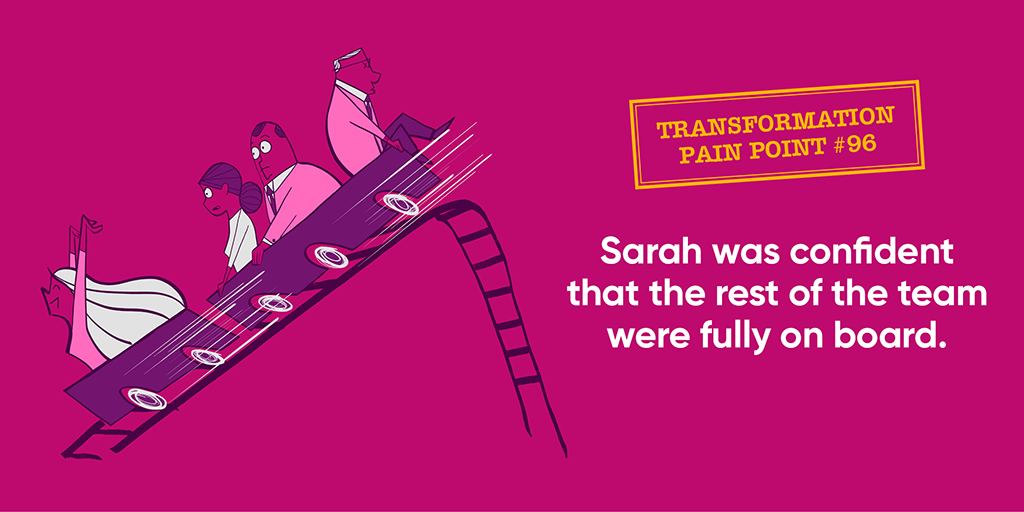Insight article

Getting the rest of the team on board
Transformation pain point #96
Let me share a story about Sarah.
Sarah was a transformation leader who was known for her ambitious visions and a strong desire to drive change. She headed a team of talented individuals at a cutting-edge tech company, and she believed that a major transformation was necessary to stay ahead of the competition.
Sarah had plans to shift the company’s focus towards envisioning a future where their products would revolutionise industries. She spent months crafting a detailed strategy, attending workshops, and consulting experts to ensure her vision was sound.
A critical misstep
However, Sarah made a critical misstep – she failed to involve her team in the transformation process. She presented the plan in a single meeting, expecting everyone to immediately rally behind her vision.
The team, however, was caught off guard. They were accustomed to their existing projects and methodologies, and the abrupt shift felt overwhelming. They had concerns about their existing skill sets becoming obsolete and feared the potential impact on their job security.
As days passed, it became evident that Sarah’s approach had caused a rift within the team. Morale and engagement plummeted, and productivity suffered. Many team members felt disheartened and disconnected, unable to see how they fit into the new direction.
Underestimated the emotional attachment
Sarah, in her determination to drive change, failed to recognise the importance of inclusivity, collaboration and communication. She had underestimated the emotional attachment her team had to the current journey and the uncertainty they felt about the future.
Recognising the growing discontent, Sarah decided to take a step back and reevaluate her approach. She started by holding meetings with her team members, but instead of delving straight into charts and data, Sarah began with a story. She emphasised the potential they held and the incredible impact they could make if they embarked on this journey together. Sarah’s storytelling didn’t end in that meeting room. She continued to weave narratives into their everyday work.
She encouraged her team members to share their own stories, fostering a culture of open communication and mutual support. These personal narratives became threads that wove the team together, creating a sense of belonging and a shared purpose.
Belief and confidence
Sarah’s efforts bore fruit. The team started to see and believe in the opportunities of the transformation and gained confidence in their ability to navigate the new landscape. Through storytelling, Sarah managed to demystify the transformation process. She made it relatable, showing her team that they weren’t alone in their uncertainties. And because of this, they began to work together seamlessly towards the shared goal, advocating for the transformation.
Through this experience, Sarah learned a valuable lesson about the importance of involving her team in the transformation process. She understood that successful change required not only a clear vision but also the support, understanding, and buy-in of the very individuals who would bring that vision to life.
Humanised the transformation
Sarah’s use of storytelling had been the catalyst for this success. It had humanised the transformation, making it something they could all relate to and rally behind. It showed them that they were not just executing a plan, but actively writing the next chapter of their company’s story.
It’s examples like this that show the true heart of mastering change.
